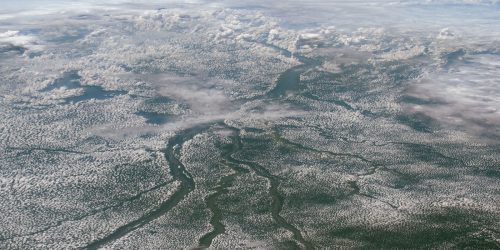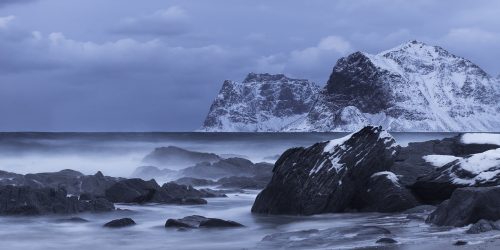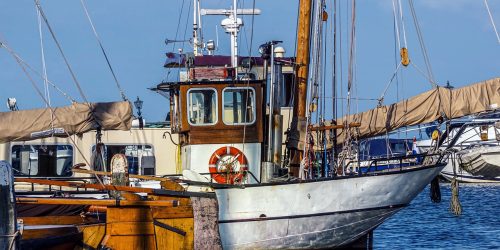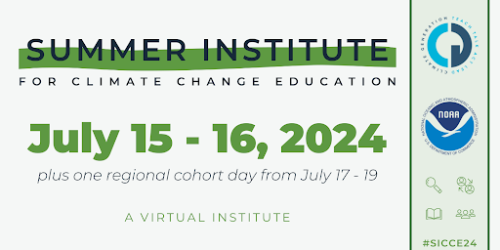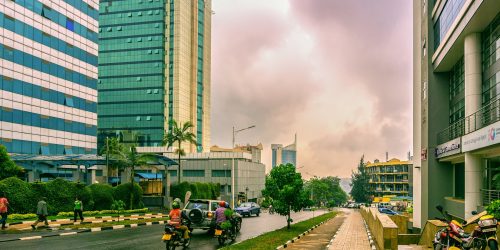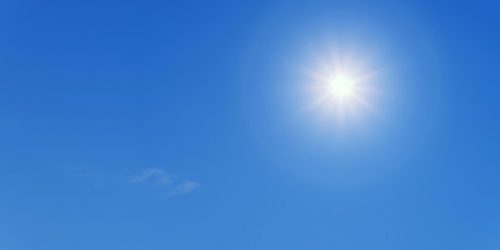By Melissa DeFrancesco, CPO CEE Division
This article kicks off a series of interviews with NOAA Climate Program Office (CPO) employees and CPO-funded scientists in celebration of Women’s History Month.
Victoria Breeze, PhD, works at the pivotal intersection of atmospheric science and climate resilience. The Colorado native was recently promoted to the position of Program Manager for the Earth’s Radiation Budget (ERB) Program within the Earth System Science and Management (ESSM) Division of CPO. In this role, Victoria oversees projects that investigate natural and human activities that might alter the reflectivity of our atmosphere, to help decision makers address knowledge gaps and guide future research on near-term climate risk. In addition to her knowledge of atmospheric science, Victoria is an accomplished communications specialist, proficient in Mandarin, and enjoys skiing.
Our conversation follows.


Victoria at a summit on Mt. Hua in Shaanxi Province, China.
Image credit: Victoria Breeze
Tell me about your career path. How did you get into the sciences?
When I was in 3rd grade I wrote that I wanted to be a marine biologist, so maybe I should have known I’d end up at NOAA. But in 4th grade I was dead set on being a sci-fi author, in middle school it was a veterinarian, in high school, a videogame designer. I had varied interests and I was privileged to come from a family that supported excelling in science, yes, but also art and music and literature. I was indecisive in undergrad too, and rather than settle on one major, I decided to triple major in Environmental Studies, Chinese Language, and International Affairs. When I graduated from CU Boulder, I worked for an environmental engineering firm, but in their marketing department writing proposals. There I was adjacent to science, I could see it happening, I wrote about it, but I wasn’t directly involved— and I knew I wanted to be. My final year of undergrad I worked with an amazing Geography professor and mentor who inspired me to go to graduate school. I applied twice, the first year I was rejected across the board. The second year all but one school accepted me. I ended up choosing to pursue a PhD in Geography at Michigan State University.
What is involved in a PhD in Geography?
We’re really the bridging discipline, trained in ecology and carbon fluxes as much as in economics and political theory. My research was at the intersection of international affairs and land use, but during my time at MSU I also worked on projects involving coupled human and natural systems models, remote sensing, climate projections, environmental journalism, sustainability, and health. I often call my educational background eclectic, but I also think it is broad in a way that is beneficial to my current role as program manager. Now, I work with scientists across a variety of disciplines and sit at the table with multiple science agencies. It’s work that requires me to think about the bigger picture, all of which, as a Geographer, I was in some way trained to do.


Victoria skiing at Copper Mountain, Colorado
Image credit: Victoria Breeze
Did your childhood in Colorado, which is known for being a great outdoor state, have any impact on your decision to pursue Environmental Studies?
I think it’s one of those things where it never consciously impacted me—it wasn’t like I stood there and said, “The mountains have spoken to me, I will do science.” But my family definitely took advantage of the outdoors. We loved camping. We’re all avid skiers and were privileged enough to be able to spend our winter weekends on the slopes. I think having natural resources nearby did inspire me to a baseline level of wanting to continue to have them nearby. As in, this is something that I got to experience, I want my kids to be able to experience it too. The opportunities I had growing up also benefited from having nature near at-hand. Even as early as elementary school, field trips involved going up to the mountains and learning about the history of the gold rush, or to the bird preserve to hear about the raptors they rescue. And then of course, my undergrad was also in Colorado, so it was similar in that field work and lab work had those unique opportunities nearby as well.
What is your favorite outdoor place in Colorado?
On the slopes. It’s a little bit corny, but I am such an avid skier, like I said. There’s a couple of spots in the mountains where, when you get in the back bowls, it’s just you and the snow is in that really soft, quiet stage where it feels like there’s a blanket over everything, and that great Colorado blue sky. When you’re skiing two miles above sea level, you can get that deep blue sky. My mom always announces “It’s the Colorado blue!” So I hear her voice in my head every time I think of it.
How/when did you start working at NOAA, and what was the path to becoming Program Manager at ERB?
I joined NOAA as a communications specialist with Earth System Science and Modeling (ESSM) in March 2020. My focus was on translating science into layman’s terms and showcasing ESSM work. Early on, I indicated interest in program management and my wonderful mentors and supervisors in CPO worked with me to find training opportunities so that when the ERB PM position opened up, I was able to put my hat in the ring. I often hear at NOAA that once you’re in, the opportunities to move to a different position are endless and I think that’s true.


Victoria with a high-altitude research aircraft for ERB’s SABRE Initiative at the NASA Johnson Space Research Center facility in Houston, TX.
Image credit: Victoria Breeze
What is Earth’s Radiation Budget (ERB)? How does it relate to climate change?
ERB is a research initiative to investigate natural and human activities that might alter the reflectivity of the stratosphere and the marine boundary layer, and the potential impact of those activities on the Earth system. The name comes from Earth’s energy budget. How much energy is coming in from the sun, how much gets reflected away by our atmosphere, how much stays here on Earth and how much flows back out to space. Contributors to and impacts of climate change alter this energy budget, e.g., greenhouse gases absorb energy before it leaves the atmosphere, aerosols can reflect back energy, melting ice sheets result in more energy absorbed at the surface, and so on. ERB is focused especially on understanding the interactions in our atmosphere that can change that energy budget.
How is work with the ERB program supporting NOAA’s climate resilience work?
Climate resilience is, by its nature, forward-looking. The ability to prepare for, adapt to but also improve or reduce harm. ERB on one hand represents work at the very beginning of this question (do we understand the impact of aerosols on Earth’s energy budget?) but also represents work at the far end of resilience (can we represent, model, simulate a world with climate intervention and study it?).
Are there any current ERB projects that you are particularly excited about?
The ERB Program currently has 6 grant awards underway, which can roughly be categorized as: (a) projects that improve modeling capabilities for forecasting how natural and human-caused aerosols influence marine clouds; (b) projects that improve understanding of the efficacy and impacts of proposed solar climate interventions; and, (c) projects focused on how model building-blocks handle stratospheric aerosols and energy. Notably—and this is my favorite part—the model improvements that will come out of these projects are applicable and useful to how we understand our Earth system in general, beyond just solar climate intervention applications. So even though we’re working on better simulations for a specific future under climate change, the things we learn while doing so can inform what we know about our atmosphere in general.
Do you recommend any resources for people looking to learn more about atmospheric science and climate change?
It depends on what level you want to jump in! The National Academy has some great reports on Climate Intervention, for example. There’s also NOAA State of the Science Factsheets for some of the basics of atmospheric science and climate change. Also, the latest IPCC report comes with some supplemental materials, such as headline summaries and FAQs, that are easy to read.
Do you have any female mentors or role models, either in your field or just people you know personally? What about them has inspired you?
Rachel Carson comes to mind, but day-to-day many of the role models that inspire me are more personal: my grandmother who raised globe-trotting daughters and they, in turn, ambitious granddaughters. In particular, I think about my Mom (one of the few women in her college majoring in Math at the time), and also the amazing women I worked with in graduate school. And now I think of my colleagues here at NOAA (from fellow program managers who’ve mentored me to a number of women across the agency who all embody some aspect of “I want to be her when I grow up” for me.).
What is one piece of practical advice you have for younger generations looking to work in climate modeling?
For anyone looking to get into climate work in general, know that there are a lot of ways to join. For climate modeling, you’re looking at physics, meteorology, math, but it can also mean almost anything and everything. Ecologists and biologists to understand environmental impacts. Economists, sociologists, historians, anthropologists for where humans meet climate. At the practical level, we need business and finance folks to dot our I’s and cross our T’s too. Also, know that your career probably won’t be a straightforward path. Mine wasn’t. Most graduates these days are going into a job market that is not as linear as it used to be. My advice would be to not get discouraged by that but explore where the turns might take you.
Special thanks to Victoria Breeze for participating in this interview for Women’s History Month at NOAA.



